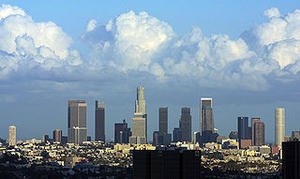Dirty bombCost of a dirty bomb attack in L.A. would reach $16 billion
A dirty bomb attack on downtown Los Angeles’ financial district could severely affect the region’s economy at a cost nearly $16 billion, fueled primarily by psychological effects which could persist for a decade

Los Angeles cleanup cost of a radiological weapon attack may reach $16 billion // Source: wikimedia.org
A dirty bomb attack on downtown Los Angeles’ financial district could severely affect the region’s economy at a cost nearly $16 billion, fueled primarily by psychological effects which could persist for a decade, according to a study by University of Southern California researchers and others.
Published by a team of internationally recognized economists and decision scientists in Risk Analysis, the study monetized the effects of fear and risk perception, incorporating them into a state-of-the-art macroeconomic model.
“Terrorism can have a much larger impact than first believed,” said study co-author Adam Rose, research professor at the USC Sol Price School of Public Policy and coordinator for economics at USC’s National Center for Risk and Economic Analysis of Terrorism Events (CREATE). “The economic effects of the public’s change in behavior are 15 times more costly than the immediate damage in the wake of a disaster.
“These findings illustrate that because the costs of modern disasters are so large, even small changes in public perception and behaviors may significantly affect the economic impact,” said Rose, who has published economic estimates of the 9/11 attacks, the Northridge earthquake, and other major disasters.
Study co-author William Burns, a research scientist at Decision Research in Eugene, Oregon, added: “We decided to study a terrorist attack on Los Angeles not to scare people, but to alert policymakers just how large the impact of the public’s reaction might be. This underscores the importance of risk communication before and after a major disaster to reduce economic losses.”
A University of Southern California release reports that economists most often focus on the immediate economic costs of a terrorist event, such as injuries, cleanup, and business closures. In this scenario, those initial costs would total just over $1 billion.
To estimate how fear and risk perception ripple through the economy after a major terrorist event, the researchers surveyed 625 people nationwide after showing them a mock newspaper article and newscasts about the hypothetical dirty bomb attack to gauge the public’s reticence to return to normal life in the financial district.
The study translated these survey results into estimates of what economic premiums would be put on wages and what discounts shoppers likely would require in the aftermath of a terrorist attack.
After six months, 41 percent of those surveyed said they still would not consider shopping or dining in the financial district. And, on average, employees would demand a 25 percent increase in wages to return to their jobs.
“The stigma generated by dirty bomb radiation could generate large changes in the perceived risk of doing business in the region,” said co-author James Giesecke of the Center of Policy Studies at Monash University. “However, with regional economies in competition with one another for customers, businesses and employees, it takes only small changes in perceived risk to generate big losses in economic activity.”
The paper relied on one of fifteen planning scenarios — the detonation of a dirty bomb in a city center — identified by DHS in an effort to focus anti-terrorism spending nationwide.
The release notes that the study was part of a larger special issue of Risk Analysis that showcased CREATE’s risk-assessment research of terrorism events, natural disasters, and their economic impacts. The special series, titled “Risk Perception Behavior: Anticipating and Responding to Crisis,” was the result of a CREATE workshop that explored possible avenues of research leading to insights in risk analysis.
DHS funded the research through CREATE and the National Science Foundation.
— Read more in J. A. Giesecke et al., “Assessment of the Regional Economic Impacts of Catastrophic Events: CGE Analysis of Resource Loss and Behavioral Effects of an RDD Attack Scenario,” Risk Analysis 32, no. 4 (April 2012): 583–600 (DOI: 10.1111/j.1539-6924.2010.01567.x)
